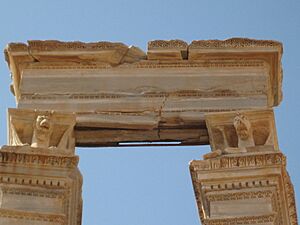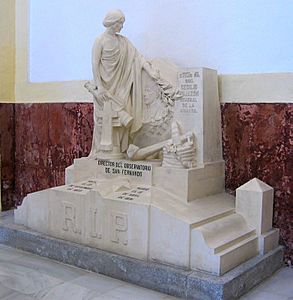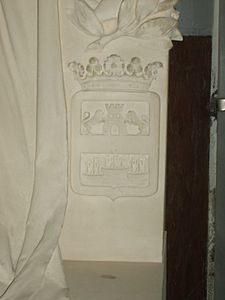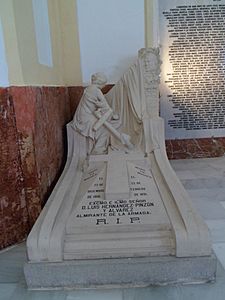Panteón de Marinos Ilustres facts for kids
| Panteón de Marinos Ilustres | |
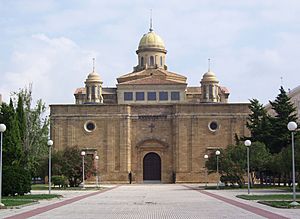
Rear facade of building. Note the Romanesque (semi-circular) doorway and the 18th century cupolas for light wells, the main one being over the opening in the main dome. A false architrave over the arch of the door bears the name of the monument in raised silver letters.
|
|
| Coordinates | 36°28′47″N 6°11′37″W / 36.4797°N 6.1937°W |
|---|---|
| Location | Military reservation of San Carlos adjacent to the north of San Fernando, Cádiz, whether on the lands of the civilian community is a moot point. |
| Designer | Initially Francisco Sabatini |
| Type | Initially intended as a parish church, it was abandoned 1805, restarted 1845 as the chapel of the new Spanish Naval Academy, converted to a mausoleum starting 1850. |
| Material | Diverse materials: Wood, stone, metal, glass, concrete, and more |
| Length | 88.57 metres (290.6 ft) |
| Width | 37.5 metres (123 ft) |
| Beginning date | 1786 |
| Completion date | 1854 |
| Dedicated to | Front inscription in Latin: OMNES.ISTI IN.GENERATIONIBUS GENTIS.SUAE GLORIAM.ADEPTI.SUNT ET.IN.DIEBUS.SUI HABENTUR IN.LAUDIBUS Spanish translation: "Todos estos alcanzaron gloria en las edades de su nacion, y en sus dias son celebrados." English translation: "All these were honoured in their generations, and were the glory of their times." |
The Pantheon of Illustrious Sailors (Spanish: Panteón de Marinos Ilustres) is a special building in Spain. It serves as a mausoleum, which is a grand tomb, and a memorial. It honors all the brave sailors of the Spanish Navy, especially those who were very famous. It also celebrates the Spanish Navy's history, its ships, battles, and amazing explorations.
The word "Pantheon" might sound like it's about all gods, but here it describes the building's style. It's built in a neoclassical style, which means it looks like ancient Roman or Greek buildings. The most famous "Pantheon" is in Rome, which was once a temple to many gods. This Spanish Pantheon, however, is a Catholic church with a cemetery added to it.
The architects in the 18th and 19th centuries used the term "Pantheon" for buildings with a large central dome. Domes are like giant arches rotated in a circle. They are very strong and can cover large spaces. The Roman Pantheon survived because it became a Christian church. Since then, domes have been a common feature in important government and religious buildings.
Contents
The Spanish naval pantheon is located in a military area called Poblado Naval de San Carlos. This area is in the Province of Cádiz, Andalusia, Spain. It's a naval base that is next to the city of San Fernando, Cádiz. Even though it's close to the city, the base is managed by the national government, specifically the Ministry of Defence.
The base was created in the late 1700s by King Carlos III. He believed it was vital for protecting Cádiz and Spain. Cádiz is on a long strip of land, so a strong base was needed to defend it. Carlos III chose Charles Borromeo as the patron saint for the area. After the king's death, the unfinished works were named San Carlos in his honor.
Years later, during the Siege of Cádiz by Napoleon's French forces, the base proved its worth. Spanish, English, and Portuguese forces successfully defended Cádiz when most of the country had fallen. After this, San Carlos became even more important. It became home to the Spanish Naval Academy and the headquarters for the Spanish marines. The Pantheon then served as the academy's chapel.
In 1943, the Naval Academy moved to a different location. In 2018, the Spanish Ministry of Defence officially declared the San Carlos area a "Zone of Interest for National Defense." This means the military has special rights over the land, ensuring its importance for national security.
Building Architecture
This building is unique because it wasn't built all at once or for just one purpose. It changed over more than 200 years. Its design combines different styles and ideas.
Building Blocks of the Pantheon
The main parts of the Pantheon's structure are the arch, the vault, and the dome. These were all used in ancient times. An arch is a curved structure that can support a lot of weight by pushing forces outwards. A vault is like a long arch, forming a ceiling. A dome is like an arch spun around a central point.
These structures work because of a simple idea: the wedge. Imagine an axe splitting wood. The axe blade is a wedge that pushes the wood apart. In buildings, stones shaped like wedges are put together to create strong arches and domes. When weight pushes down on an arch, the force is spread out along the curve, pushing the stones together. Stone is very strong when compressed.
This is different from a straight beam, called a lintel, which simply rests across an opening. Lintels can sag and break under heavy loads because they are pulled apart (tension). Arches are much stronger for supporting heavy structures, which is why many ancient arches still stand today, unlike most ancient lintels.
How the Pantheon is Designed
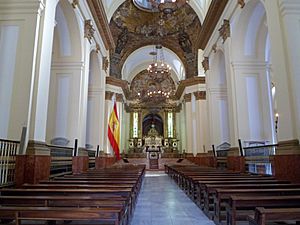
The inside of the Pantheon looks like a grand church from the Renaissance period. It has a nave (the main hall for people), an apse (a special area usually at the end of the church), and a bema (a raised platform for ceremonies). It also features beautiful arches, vaults, and domes.
When King Carlos III started the project, he wanted a magnificent church to show the power of the Spanish Empire. However, after his death, the project was put on hold due to financial difficulties. The country needed money for its military, not for expensive buildings.
Work on the building restarted in the mid-1800s with a new purpose. It was no longer just a community church. It became the chapel for the Spanish Naval Academy. The goal was to celebrate the history of the Spanish Navy and its heroes.
So, the Pantheon became like two buildings in one. The inside is a splendid cathedral, decorated with frescoes and Baroque art. Monuments to famous sailors are placed throughout. There's a lot of gold and silver, making it look very rich. However, the outside of the building is quite plain and block-shaped. You can't see the arches, vaults, or domes from the outside. All the support structures are hidden within the walls. Unlike other famous domed buildings, the Pantheon of Illustrious Sailors keeps its grandeur mostly on the inside. Today, it's a popular place for tourists to visit.
Decorations and Art
Besides its impressive architecture, the Pantheon has many beautiful decorations and artworks. These include elaborate designs on the walls and arches, as well as statues and other valuable pieces. Most of these decorations have a special meaning related to the monument's theme: celebrating the triumphs of the church and, in this case, the brave sailors. It shows that true honor comes from a person's character and heroic actions, not just their wealth or status.
Honoring Spanish Mariners
Many distinguished Spanish sailors are buried or honored with monuments here. While the general rule was to honor officers, some enlisted men were also included, sometimes anonymously in groups. In at least one special case, a seaman who died bravely for his country was honored by name. The mausoleum also includes a "tomb of the unknown sailor" and a dedication to all mariners who served in the Spanish Navy, regardless of their rank.
Here is a list of some of the famous mariners honored in the Pantheon:
| Death | Given name | Surnames | Notable Achievements | English Wikipedia link |
|---|---|---|---|---|
| 1891 | Cecilio | Pujazón y García |
Astronomer and director of the Royal Institute and Observatory of the Navy. | Cecilio Pujazón y García |
| 1817 | Ignacio | Maria de Álava y Sáenz de Navarrete |
Admiral of the Spanish fleet, known for his loyalty to Spain. | Ignacio Maria de Álava y Sáenz de Navarrete |
| 1872 | José | Fernández Acevedo |
First Mate, killed during the 1872 Cavite mutiny. | José Fernández Acevedo |
| 1805 | Dionisio | Alcalá Galiano | Explorer, cartographer, and commander killed at the Battle of Trafalgar. | Dionisio Alcalá Galiano |
| 1805 | Francisco | Alcedo y Bustamante |
Naval officer with experience in colonial voyages, killed at the Battle of Trafalgar. | Francisco Alcedo y Bustamante |
| 1898 | José | Alvariño Gabeiras |
Seaman First Class, honored for his bravery during the Battle of Santiago de Cuba. | José Alvariño Gabeiras |
| 1797 | Claude | Francois Renard de Fuchsemberg |
French nobleman who became a commodore in the Spanish navy, killed at the Battle of Cape St Vincent (1797). | Conde de Amblimont |
| 1890 | Juan | Bautista de Antequera y Bobadilla de Eslava |
Distinguished fighting commander, Senator, and Secretary of the Navy. | Juan Bautista Antequera y Bobadilla |
| 1866 | Francisco | Armero y Fernández de Peñaranda |
Naval officer who became Secretary of Navy and Prime Minister. | Francisco Armero Peñaranda |
| 1797 | Antonio | Barceló y Pont de la Terra |
Started as a privateer and rose to become an admiral, fighting Algerian pirates. | Antonio Barceló |
| 1588 | Álvaro | de Bazán y Guzmán |
Professional naval officer, known for never losing a battle. | Álvaro de Bazán, 1st Marquis of Santa Cruz |
| 1898 | Joaquín | Bustamante y Quevedo |
Naval officer and inventor, wounded in the Battle of Santiago de Cuba. | Joaquín Bustamante y Quevedo |
| 1868 | José María | Bustillo y Gómez de Barreda |
Joined the Navy at 14, rose to admiral and Minister of the Navy. | José María Bustillo y Barreda |
| 1842 | Diego | Butrón y Cortés |
Naval officer who fought in many battles and rose to ministerial rank. | Diego Butrón Cortés |
| 1936 | Pedro Maria | Cardona y Prieto |
Naval officer, shot during the Spanish Civil War for refusing to command the Republican Navy. | Pedro Cardona Prieto |
| 1821 | Juan José | de Carranza y Vivero |
Naval officer, wounded and captured at the Battle of Trafalgar, killed in action in 1821. | Juan José Carranza Vivero |
| 1915 | José | de Casado y Ferreiro |
Petty Officer, honored for saving a man at the Battle of Santiago de Cuba. | José Casado Ferreiro |
| 1909 | Pascual | Cervera y Topete |
Rear Admiral who led Spanish forces at the Battle of Santiago de Cuba. | Pascual Cervera y Topete |
- Juan Cervera Valderrama
- José María Manuel Céspedes y Pineda
- Francisco Chacón Medina Salazar
- Cosme Damián de Churruca y Elorza
- Gabriel Císcar y Císcar
- Christopher Columbus
- Víctor María Concas y Paláu
- José de Córdoba y Rojas
- Luis de Córdova y Córdova
- Juan de la Cosa
- Manuel Deschamps Martínez
- Juan Domingo Deslobbes y Cortés
- Segundo Díaz de Herrera y Serrano
- Juan Díaz de Solís
- José Luis Díez y Pérez Muñoz
- Juan Manuel Durán González
- Manuel Emparán de Orbe
- Antonio de Escaño y García de Cáceres
- José Esguerra y Guirior
- Cesáreo Fernández Duro
- Tomás Geraldino Geraldino
- Nicolás Geraldino Sutón
- José Goicoa Labart
- José González Hontoria
- Federico Carlos Gravina y Nápoli
- Julio Guillén Tato
- Juan Antonio Gutiérrez de la Concha
- Mateo Hernández Ocampo
- Luis Hernández Pinzón y Álvarez
- Francisco Herrera Cruzat
- Baltasar Hidalgo de Cisneros
- Jaime Janer Róbinson
- Jorge Juan y Santacilia
- Ángel Laborde Navarro
- Rafael De Laiglesia Darrac
- José María Lazaga y Ruiz
- Blas de Lezo
- Santiago Liniers y Bremond
- Miguel Lobo y Malagamba
- Ferdinand Magellan
- Alejandro Malaspina Melilupi
- José Malcampo y Monge
- Francisco de Paula Márquez y Roco
- Cripiano Mauleón Godoy
- Ignacio María Mendizábal Vildosola
- Casto Méndez Núñez
- Augusto Miranda Godoy
- Francisco Moreno Fernández
- Salvador Moreno Fernández
- Francisco Antonio Mourelle de la Rúa
- Juan José Navarro de Viana y Búfalo
- José Navarro Torres
- Pedro Novo y Colson
- Nicolás Otero Figueroa
- Martín Alonso Pinzón
- Vicente Yáñez Pinzón
- Rosendo Porlier y Astiegueta
- Andrés Reggio Brachiforte
- Francisco Riquelme Ponce de León
- José Rodríguez de Arias y Álvarez Campana
- Juan Ruiz de Apodaca y Eliza
- Francisco Javier de Salas y Rodríguez-Morzo
- Blas Salcedo y Gutiérrez del Pozo
- Victoriano Sánchez Barcáiztegui
- Pedro Pablo Sanguineto Basso
- José de la Serna y Occina
- José Solano y Bote
- Zenón de Somodevilla y Bengoechea
- Vicente Tofiño de San Miguel y Vandelvalle
- Joaquín Toledo y Parra
- Antonio de Ulloa y de la Torre-Giralt
- Francisco Javier de Uriarte y Borja
- Cayetano Valdés y Flores
- Juan Varela Ulloa
- Casimiro Vigodet y Garnica
- Fernando Villaamil y Fernández Cueto
- Juan María de Villavicencio y la Serna
- Francisco Javier Winthuysen y Pineda
- Antonio Yepes Arigori
- Joaquín Zarauz Santander
Images for kids
Gallery of Gravestones
See also
 In Spanish: Panteón de Marinos Ilustres para niños
In Spanish: Panteón de Marinos Ilustres para niños



